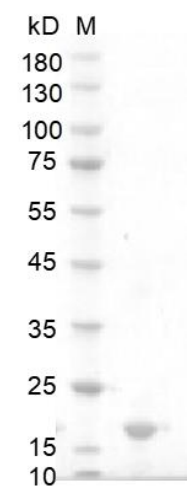| Product name | Human IFN-α1a protein |
| Sequence | Amino acid sequence derived from Human IFN-α1a (Cys4-Glu189) (P01562) was expressed. |
| Applications | No tag |
| Applications notes | Human |
| Activity | Testing in progress |
| Protein length | The recombinant Human IFN-α1a Protein consists of 186 amino acids and predicts a molecular mass of 23 kDa. |
| Preparation method | E.coli |
| Purity | > 95 % as determined by SDS-PAGE |
| Molecular Formula | 23 kDa |
| Alternative | Leukocyte Interferon; IFNA2; B cell Interferon; Type I Interferon |
| Formulation | Lyophilized from sterile 20 mM PB,50 mM NaCl,pH 7.5. |
| Features & Benefits | Endotoxin : < 0.1 EU per μg of the protein as determined by the LAL method. |
| Molecular weight | 23 kDa |
| Usage notes | Always centrifuge tubes before opening. It is recommended to reconstitute the lyophilized protein using the buffer we provided not less than 100 µg/ml, which can then be further diluted to other aqueous solutions. |
| Storage instructions | Lyophilized protein product should be stored desiccated below -20°C. Upon reconstitution, the protein should be stored at 4°C between 2-7 days and for future use below -20°C. For long term storage |
| Shipping | Gel pack with blue ice. |
| Precautions | The product listed herein is for research use only and is not intended for use in human or clinical diagnosis. Suggested applications of our products are not recommendations to use our products in violation of any patent or as a license. We cannot be responsible for patent infringements or other violations that may occur with the use of this product. |
| Background | Interferon-α1 is a member of the Type I IFN family best known for their antiviral activity. Most nucleated cells produce one or more Type I IFNs in response to viral infection. Secreted Type I IFN then induces viral protective responses in neighboring non-infected cells. Type I IFNs also enhance virus-induced apoptosis. Other IFN-α1 activities include enhancement of dendritic cell maturation and cytotoxic T cell activity. IFN-α1 binds to the IFN-αR1 and IFN-αR2 heterodimer.Intracellular signaling through the Jak/Stat pathway is best characterized. However, the PI3K, ERK, and p38 kinase pathways are also involved. The antiviral activities of the IFNs have led to their use in treating viral infections. Type I IFNs also appear to have an integral role in several autoimmune diseases. |
| Gene ID | 3439 |
| Alternative | Leukocyte Interferon; IFNA2; B cell Interferon; Type I Interferon |
| Accession | P01562 |

You must be logged in to post a review.
Reviews
There are no reviews yet.